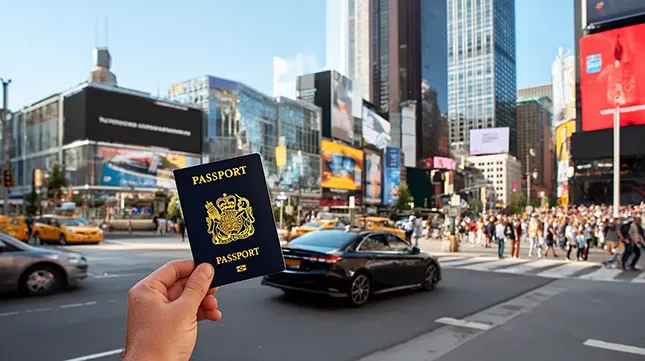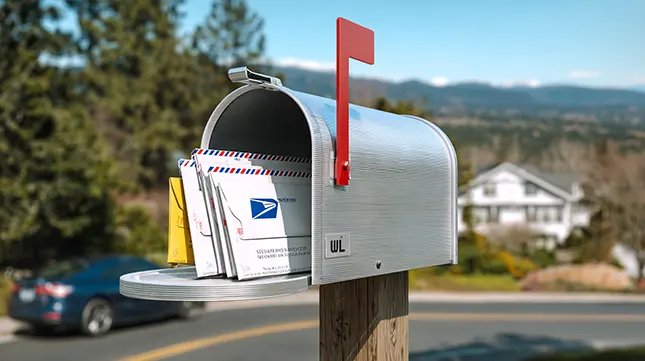Moving to USA from UK – 53 Top Emigrating Facts

If you are thinking about moving to the USA from the UK, here’s what to expect.
Uprooting your life and moving from the UK to the USA is a big decision, but one that can open the door to incredible new opportunities.
Whether you’re chasing career growth, better weather, or a fresh start, America has long been a magnet for Brits seeking adventure, freedom, and a diverse lifestyle.
Spanning almost the entire continent of Europe, the USA is the third-largest country on the planet and home to nearly 45 million immigrants, more than any other nation.
From the towering skyscrapers of New York City to the peaceful suburbs of New England or the sun-drenched coasts of California, there’s no one-size-fits-all version of life in the States.
But with 50 very different states to choose from, narrowing down where to live can feel overwhelming.
And then there’s the paperwork to consider! America’s visa and immigration systems are famously complex.
Still, millions have done it before you, and with the proper guidance, you can too.
This guide to 53 essential facts about moving to the USA from the UK will help you understand what’s involved, what to expect, and how to prepare for your exciting new chapter.
1. A Bold Leap: Why Brits Move to the USA

The USA attracts over 1.3 million British expats with its career potential, lifestyle diversity, and promise of the American Dream.
The USA continues to attract Brits seeking more than just sunshine.
Whether it’s career advancement, entrepreneurial ambition, or simply a fresh start, the U.S. offers scale, variety, and opportunity. With over 1.3 million British expats now calling America home, you’re far from alone.
From sprawling fast-paced cities to quiet coastal town retreats, you’ll find spaces that suit every lifestyle.
It’s a cultural shift, sure, but also a thrilling adventure. The appeal? English is the dominant language, salaries can be higher, and you get a shot at the famed “American Dream.”
Whether you’re relocating solo or with your family, the U.S. offers possibilities that often feel limitless.
For many Brits, it’s not just a move—it’s a lifestyle reinvention.
2. H-1B Visa – Skilled Workers in Specialised Fields

From H-1B and L-1 work visas to E-2 investor options, the U.S. offers multiple legal pathways for UK citizens relocating across the Atlantic.
There are numerous types of USA entry visas, depending on your reasons for visiting the States and your personal situation.
The H-1B visa is the go-to route for professionals in fields like IT, finance, medicine, and engineering. It requires sponsorship from a U.S. employer willing to petition on your behalf.
You’ll need at least a bachelor’s degree (or equivalent) and proof that your skills match a role that a U.S. citizen can’t easily fill.
The visa is valid for up to six years, typically issued in three-year chunks.
Bear in mind the annual cap, currently 85,000 visas, makes it highly competitive, with selection via a lottery system.
If you’re considering this path, timing is critical. Applications open in early spring each year.
3. L-1 Visa – Intra-Company Transfers
The L-1 visa is perfect if you already work for a UK-based company with U.S. operations.
This visa allows you to transfer to a U.S. branch or affiliate, either in a managerial/executive role (L-1A) or with specialist knowledge (L-1B).
You’ll need to have worked at your company for at least one continuous year within the last three.
It’s ideal for global businesses looking to relocate key staff or expand in the United States.
The L-1 visa typically lasts for 1–3 years initially, with extensions possible up to 7 years. Your spouse may apply for a work permit too.
4. Family and Marriage-Based Visas
If you’re marrying a U.S. citizen or joining immediate family, a family-based visa may be your route in.
U.S. citizens can sponsor foreign spouses, children, parents, and siblings.
The IR-1 (Immediate Relative) visa is standard for spouses and usually leads to a Green Card within a year.
There’s also a K-1 visa for fiancés, allowing you to enter the U.S. and marry within 90 days.
Family reunification visas are a generous pathway but involve proving a bona fide relationship and meeting financial sponsorship thresholds.
Processing times vary depending on visa type and the USCIS backlog.
5. E-2 Visa – The Entrepreneur’s Gateway
The E-2 visa is designed for foreign nationals investing in a U.S. business.
There’s no set minimum investment, but anything below $100,000 may struggle to be approved.
You’ll need to show you’re actively involved in managing the business and that it’s not marginal, i.e., it should employ U.S. workers and generate real income.
While the E-2 visa doesn’t lead directly to a Green Card, it’s renewable indefinitely as long as the business remains operational.
Only citizens of treaty countries like the UK are eligible. A solid business plan and legal support are a must.
6. Green Card – The Path to Permanent Residency
A Green Card grants you permanent residency in the U.S., allowing you to live and work anywhere in the country.
You can obtain one through family sponsorship, employer sponsorship, or by applying under specific categories like asylum or investment (EB-5).
Once granted, it’s valid for 10 years and is renewable. After five years of holding a Green Card, you may become eligible for U.S. citizenship.
It’s a lengthy process involving background checks, interviews, and documentation, but it’s the most stable long-term option for living in the States.
7. Diversity Visa Lottery – A Long Shot Worth Taking
The Diversity Visa Lottery, also known as the Green Card Lottery, is open to nationals from countries with low immigration rates to the U.S., and yes, the UK still qualifies (except Northern Ireland-born applicants).
Every year, 55,000 visas are randomly awarded, and entry is free via the official website.
If selected, you’ll undergo the same vetting as any other immigrant, including background checks and a visa interview.
Entry dates typically fall in October–November, with results released the following May.
NOTE: Ignore third-party “lottery services”; they’re often scams.
8. Getting a Social Security Number (SSN)
One of your first steps after arriving in the U.S. is applying for a Social Security Number (SSN).
It’s essential for working, paying taxes, opening a bank account, and accessing public services.
Most people apply as part of their visa process or in person at a Social Security Administration (SSA) office.
Take your passport, visa, I-94 arrival form, and proof of address. Processing can take up to two weeks, so don’t delay. Y
our SSN will become a key piece of ID similar to your National Insurance number in the UK; treat it with care. Without it, you’ll struggle to get a job, secure credit, or rent a home.
9. Opening a U.S. Bank Account

Set up U.S. bank accounts early, build credit with a secured card, and manage your finances like a local from day one
Setting up a checking account is going to be a top priority when you land.
There are plenty of banks to choose from, and you can open a bank account before you arrive, which makes things a bit easier.
If you haven’t secured a permanent U.S. address yet, getting started with a traditional American bank can be challenging. Many banks require proof of local residence, which puts newcomers in a catch-22.
A smart workaround is to go with an international bank that operates in both the UK and the U.S., and HSBC is a prime example. They offer cross-border banking services designed specifically for expats, letting you set up your U.S. account from the UK before you even touch down. It’s a hassle-free way to manage your money on both sides of the Atlantic.
However, banks like Chase, Bank of America, and Wells Fargo have beginner-friendly accounts.
You’ll need ID (passport and visa), proof of U.S. address, and possibly a Social Security Number.
Some banks accept ITINs (Individual Taxpayer Identification Number) if you don’t yet have an SSN.
Credit is key in the U.S., so pair your account with a secured credit card to start building history.
Online-only banks like Chime or Ally are growing in popularity, too.
10. Thriving in the American Job Market

Explore a vibrant U.S. job market filled with opportunities for UK expats.
Finding work in the United States can be a gateway to exciting career development, especially for skilled professionals arriving from the UK.
From Fortune 500 giants to innovative start-ups, the American job landscape is rich and varied.
High-demand sectors include aerospace, consumer technology, healthcare, and advanced manufacturing, many of which actively seek overseas talent.
While not having a green card can seem like a hurdle, patience and persistence often pay off.
If you’ve already secured a role, you’ll find many U.S. companies value drive and reward growth quickly.
And if you’re still looking? Start with www.USAjobs.gov, the official portal for federal opportunities, or explore global job boards like Indeed USA and LinkedIn.
With the right strategy, your American career journey could be just getting started.
11. Understanding Work-Life Balance in the U.S.
When relocating to the U.S., one area that often catches newcomers off guard is the country’s work-life balance.
Unlike many European nations, the U.S. tends to lean toward longer working hours and fewer paid holidays, something worth noting if lifestyle is a top priority.
According to Axios (2024), around 11% of American workers regularly clock more than 50 hours per week.
Meanwhile, OECD data ranks the U.S. 29th out of 41 countries for achieving a healthy work-life balance, putting it firmly in the lower half.
This imbalance is often shaped by profession and income level. For example, those in high-pressure roles may have limited free time, while others with more flexible jobs enjoy greater autonomy.
Before making the move, consider not only your industry but also how your job will shape evenings, weekends, and social life.
It’s a crucial part of creating a fulfilling life in the U.S.
12 Paying U.S. Taxes: What Brits Need to Know
If you thought HMRC was tricky, welcome to the world of U.S. taxation.
Unlike the UK’s streamlined system, the U.S. has a progressive tax structure with seven income brackets ranging from 10% to 37%.
Your rate depends not only on earnings but also on filing status; be it single, married jointly, or head of household.
For instance, an income of around £50,000 ($65,000) would usually land you in the 22% federal tax bracket.
But that’s not all, depending on where you live, you may also pay state income tax, which varies by state (some, like Florida and Texas, have none).
U.S. taxes fund services like Medicare and defence, not universal healthcare.
For full, up-to-date tables and filing resources, visit the IRS – Internal Revenue Service.
13. Claiming Your UK Pension While Living in the USA

Yes, you can still receive your UK pension while living in the U.S.
Good news, if you’ve paid enough UK National Insurance contributions, you can still claim your British State Pension after relocating to the U.S.
Even better, your payments will continue to rise annually thanks to the UK–USA reciprocal agreement.
Over in America, the typical retirement package combines Social Security benefits with private savings plans like the 401(k).
Full U.S. benefits usually kick in at age 67, although early withdrawals from 62 are possible you can expect a 20–30% reduction in monthly payouts if you go early.
Your UK pension can be paid into a U.S. bank or left in a UK account.
Since both systems involve different rules, tax implications, and access ages, it’s worth speaking to a specialist. You can also find out more via the UK government’s website page Claim State Pension Abroad.
14. What Happens to Your UK Benefits When You Move
If you receive UK state benefits, be aware that most income-based payments stop if you’re abroad for more than four weeks.
This includes Pension Credit, Housing Benefit, and other means-tested support.
Before you leave, notify HMRC and the DWP; failing to do so could result in overpayments or fines.
Once you’re living in the U.S., you won’t be eligible for these UK benefits unless you’re returning shortly.
However, you can begin building entitlement to U.S. benefits, starting with a Social Security Number (SSN).
For guidance on both UK and U.S. systems, check out the links below:
UK Benefits Abroad
15. Private Healthcare vs the NHS

Private health insurance is a must-have for life in the States.
Healthcare in the U.S. can be a shock for Brits used to the NHS. Most medical care is private and billed, often at high rates.
That’s why ensuring you have adequate health insurance is vital. Your policy should cover doctor visits, hospital stays, surgery, and prescriptions.
If you’re working, your employer may provide a plan. If not, compare policies on HealthCare.gov.
You’ll pay monthly premiums and “out-of-pocket” costs like deductibles and co-pays.
Urgent care without coverage can cost thousands of dollars.
Prescription drugs are usually paid for partially by insurance or in full without a plan.
For more information and a UK vs USA healthcare comparison, visit the Our Community Media website.
16. Renting or Buying Property Stateside

Discover the pros and cons of renting vs buying in the American market.
You are going to need a place to live when you get to the States.
Brits can legally buy property in the U.S. without needing to be a citizen or permanent resident.
That said, buying as a non-resident might involve higher mortgage rates, larger down payments, and tighter lending terms.
You may find our blog “Buying a House in the USA as an Expat” helpful.
Most newcomers rent first, allowing time to explore neighbourhoods, job commutes, and lifestyle needs.
Property prices vary drastically, from sky-high in New York or San Francisco to reasonable in the Midwest or parts of Florida.
Use sites like Zillow and Realtor.com to compare property prices by region.
Renting typically requires proof of income, a credit score (or workaround), and a security deposit.
17. Cost of Living in the USA

From housing to healthcare, U.S. living costs vary wildly by state.
The cost of living in the U.S. is wildly inconsistent depending on the state or city.
A London budget might stretch nicely in North Carolina, but feel painfully tight in San Francisco or New York.
In general, expect to pay more for healthcare, housing, and groceries, but less for fuel and fast food.
Don’t forget about sales tax, it varies by state and is added when you are at the checkout.
Sites like Numbeo can give you a side-by-side comparison of UK vs U.S. prices.
Take a look at our blog outlining all you need to know about the cost-of-living differences between the UK and the USA.
18. Build your US Credit Score
For your information, your UK credit history doesn’t transfer across the Atlantic.
That means you’ll start from scratch in the U.S. which affects everything from renting a flat to buying a car.
Start by opening a checking account with banks like Bank of America, Wells Fargo, or Chase.
Then apply for a secured credit card to begin building credit. Avoid going over 30% of your credit limit and pay on time each month.
Use services like Experian USA or Credit Karma to monitor your new score.
It might take a year to build trust, so the earlier you begin, the better. Check out nerdwallet for some tips and advice.
19. Schooling Options for UK Families

U.S. schools vary by district — research early for the right fit.
If you’re moving with kids, their education will be a top priority and one that you need to get sorted as soon as possible.
Public (state) schools in the U.S. are free but vary widely in quality. They’re zoned, meaning where you live determines which school your child attends.
Research districts carefully using GreatSchools.org.
Private and international schools exist, too, but fees can be steep.
The U.S. school year typically starts in August or September and runs to May or June, with a long summer break.
If your children have special educational needs, make sure to ask schools about support services and Individualised Education Programs (IEPs).
For a complete explanation of the American school system, visit MoveHub’s excellent blog on the subject.
20. Driving Rules You Should Know

Rules of the road are different in the U.S. — prepare before you drive.
You’ll likely need to swap your UK licence for a U.S. one eventually, especially if you’re staying long-term.
Some states allow you to drive on a UK licence for up to 12 months; others don’t.
Visit your state’s Department of Motor Vehicles (DMV) website for local rules.
The driving experience feels very different; automatic cars, four-way stops, and turning right on red lights are the norm.
Speed limits vary by state and are strictly enforced.
You’ll need to organise car insurance, and in some states, proof of residency to register a vehicle.
21 Still Have a Say: Voting from Abroad
Just because you’ve moved to the States doesn’t mean your UK voice goes unheard.
As of 2024, British citizens can register as overseas voters for up to 15 years after leaving the UK. You can vote in general elections and referendums — simply register online via the UK Government’s official site.
However, when it comes to voting in the U.S., things are different.
If you’re not an American citizen, you’re barred from voting in federal, state, or local elections, even if you’ve lived there for years on a green card.
Want to stay politically active? Keep tabs on UK developments and cast your postal or proxy vote when election time comes around.
22 Welcoming a Baby in the USA

Babies born in the U.S. automatically gain American citizenship.
If you’re starting or growing your family in the United States, it’s essential to understand how birth registration works.
Unlike the UK, registration in the U.S. is handled at the state level, so procedures can vary depending on where your child is born.
However, it’s a legal requirement to register the birth and once done, you’ll receive a U.S. birth certificate.
Under jus soli laws still in effect as of late 2024, any baby born on American soil is automatically granted U.S. citizenship, no matter the parents’ nationality.
That means your child will hold dual nationality if you remain British.
For current regulations and application guidance, check the U.S. Birth Certificate website.
23 Losing a Loved One While Abroad
No one wants to think about it but understanding how to handle a death in the U.S. can provide clarity during a difficult time.
The process begins by registering the death with local state authorities, which will issue a U.S. death certificate.
From there, if you wish, you can notify UK services through the “Tell Us Once” program. This is particularly helpful if you need to update records, pensions, or legal documentation back home.
The U.S. Government also offers clear guidance for residents dealing with bereavement, including help with repatriation.
Planning ahead may not feel pleasant, but knowing the steps can ease the load when it matters most.
24 Getting Hitched Stateside: What You Need to Know
Planning a wedding in the U.S.?
Whether you’re tying the knot with a local or a fellow expat, make sure you understand the marriage visa rules.
If your partner is a U.S. citizen or green card holder, marriage could open the door to permanent residency, but it’s not instant. You’ll need to complete forms, submit supporting documents, and attend interviews.
Even civil ceremonies must follow state-specific legalities.
Love first, paperwork second — but don’t underestimate how long it can take.
Want to get a clearer picture? Visit USCIS.gov for official details on spouse sponsorship and visa pathways.
25 Faith in the USA: A Broader Religious Landscape
America’s approach to religion is shaped by the First Amendment, which fiercely protects freedom of worship.
As a result, religion is often more visible in public life than back in the UK, think open prayers at school events or Sunday services filling local diners.
As of 2024, approximately 63% of Americans identify as Christian, encompassing a range of Protestant and Catholic denominations.
But this is a country of contrasts, from deeply religious communities to proudly secular cities.
Other major faiths such as Judaism, Islam, Hinduism, and Buddhism are all represented, particularly in diverse urban centres.
You’re free to follow your own path, or none at all, without restriction in America.
26 Bringing Pets Across the Pond

Your furry friends are welcome in the U.S. with the right paperwork.
Moving with pets? Good news: importing your dog or cat to the U.S. is generally straightforward if you tick the right boxes.
The CDC and USDA oversee entry rules, which vary depending on where you’re coming from.
Your first step is a microchip for easy ID, followed by up-to-date vaccinations, especially rabies.
Most states will also ask for an official vet health certificate no more than 10 days before travel.
Be aware: stricter rules may apply for certain breeds or animals arriving from high-risk rabies zones.
Planning ahead is key, so always check the latest USDA pet import guidance before booking flights.
With the paperwork sorted and proper prep in place, your furry companion should have a smooth landing in their new American home.
27 Dialling 911: Emergency Help at Your Fingertips
Knowing who to contact in an emergency could literally be the difference between life and death.
In the U.S., 911 is your go-to number for any emergency, whether it’s police, fire, or medical. The system is remarkably efficient and widespread, covering even rural areas thanks to Quick Response Services (QRS) and regional dispatch coordination.
On average, response times sit around 8 minutes, though more remote places may experience a slight delay.
These teams are trained to stabilise situations fast and often provide critical help before an ambulance even arrives.
For new arrivals, it’s also worth knowing that language assistance services are available via 911 in many areas, ensuring support isn’t lost in translation.
Bottom line? Whether you’re in a small town or a sprawling city, America’s emergency network is primed to respond swiftly when you need it most.
28. Living Well: What Quality of Life Looks Like in the U.S.
“Quality of life” is a catch-all term, but in the U.S., it often comes down to location, income, and access.
The OECD’s 2024 Better Life Index places the U.S. high for housing, earnings, and personal safety, though it lags in areas like work-life balance and healthcare affordability.
Life here can feel incredibly rewarding, think spacious homes, stunning national parks, and vibrant cities.
But the cost of living and health insurance can impact your overall well-being.
Strong community support, access to nature, and career opportunities all play a role in shaping your experience.
So, before you make the leap, weigh what matters most: is it financial growth, social connection, or peace of mind?
29 Vacation, American Style: Why Many Stay Stateside

From Yellowstone to Miami, domestic travel in the U.S. is world-class.
When it comes to time off, Americans tend to holiday at home.
In fact, fewer than half of U.S. citizens hold a passport, meaning overseas travel isn’t nearly as common as it is in the UK, where roughly 80% of the population is passport-equipped and ready for foreign adventure.
But staying domestic doesn’t mean missing out.
With its staggering variety of climates, landscapes, and attractions, the U.S. offers a range of experiences, from beach breaks and ski resorts to desert retreats and cultural cities, all within its borders.
Whether it’s a road trip along Route 66 or hiking in Yosemite, Americans have plenty of options on home turf.
As a UK expat, you might find “vacationing” here surprisingly diverse and more budget-friendly than international travel.
30 From Smog to Snow: Understanding America’s Climate & Air Quality
The U.S. spans multiple climate zones, from the subtropical warmth of Florida to the alpine chill of Colorado.
As you plan your move, it’s essential to be aware that air quality varies significantly by region.
According to the U.S. Environmental Protection Agency (2024), pollution levels are typically higher in eastern states, especially around dense metro areas.
In contrast, western states like Utah, Colorado, and New Mexico often report cleaner air, though seasonal wildfires can cause temporary spikes in pollutants.
Whether you’re moving for work, lifestyle, or health reasons, researching your destination’s environmental profile will help you prepare for everything from weather extremes to respiratory conditions.
Check AirNow.gov for daily updates.
31 Where People Live — and Why It Matters

Population density ranges from city-packed coasts to wide-open spaces.
America’s population hit an estimated 333 million in 2024, a sharp climb from just 100 million a century ago.
While the East Coast remains the most densely populated, with historical hubs like New York and Boston, the West Coast boasts powerhouse cities such as Los Angeles, San Francisco, and Seattle.
Want space to breathe? States like Idaho, Utah, Colorado, and New Mexico offer low population density, less pollution, and stunning natural surroundings.
The country’s size means you can choose from bustling city life, suburban convenience, or rural tranquillity, depending on your lifestyle needs.
To explore detailed demographics, visit the official U.S. Census Bureau for maps and trends in the US state by state.
32 Nature’s Playground: Discovering U.S. Flora and Fauna
From sun-scorched deserts to misty mountain forests, the U.S. is a botanical and ecological goldmine.
Its sheer scale means the natural environment shifts dramatically from state to state.
Head to Texas and you might spot the elusive Living Rock Cactus, an expert in camouflage among the rocky terrain.
Fly over to Hawaii, and you’ll find the vibrant Koki’o Flower blooming on tall native trees, a symbol of the islands’ unique ecosystem.
The U.S. offers countless opportunities to immerse yourself in wild, untouched beauty. Whether you’re a casual hiker or an amateur botanist, there’s no shortage of landscapes to explore.
To learn more about the country’s native species and protected areas, visit the National Park Service website for inspiration and trail info.
33 Wildlife Like Nowhere Else
If spotting local wildlife excites you, the U.S. won’t disappoint.
With over 400 types of mammals, 800 bird species, and more than 10,000 insect varieties, the country is teeming with creatures rarely — if ever — seen in the UK.
You might catch sight of a black-footed ferret in the open plains or hear the signature call of a loon’s cry by a northern lake.
Out in Hawaii, the endangered monk seal lazes on sandy shores, while back on the mainland, groundhogs and raccoons wander freely.
America’s diverse terrain supports everything from mountain lions to moose.
Whether you’re exploring a national park or just your local greenway, there’s always something fascinating nearby.
For curious explorers, the U.S. is truly a wildlife wonderland.
34 A Country of Contrasts: U.S. Weather Unpacked
Trying to define American weather is like trying to summarise an entire continent; it’s just too varied.
The climate shifts dramatically depending on location, and seasonal swings can be intense.
Alabama, for instance, feels almost tropical in summer, reaching highs around 33°C (91°F), but can dip to a cool 2°C (36°F) in January.
Meanwhile, Alaska lives up to its frosty reputation, with winter lows of -11.6°C (11°F) and summer peaks around 18.6°C (65°F).
From humid subtropical zones to arid deserts and snowy mountain towns, where you choose to settle will have a major impact on your day-to-day climate.
For local forecasts, severe weather alerts, or long-term patterns, check out weather.com or the National Weather Service before making plans.
Relocating to the U.S. from the UK is a cultural shake-up, not in language, but in tone, tempo, and traditions.
While both countries speak English, humour doesn’t always travel well. British sarcasm can fall flat in the U.S., where directness and upbeat positivity often take centre stage.
Americans are typically more expressive and open, which can feel forward if you’re used to a more understated British style.
Workplace culture also differs, with fewer holidays, more emphasis on self-promotion, and often a year-long wait for paid vacation.
Friendships form quickly but can feel more casual at first. That said, most newcomers soon adjust to the pace.
The key? Stay curious, be open, and let those cultural quirks become part of the adventure.
36 Planting New Roots: Embracing American Life

Even small cultural differences can take new arrivals by surprise.
Starting afresh in the U.S. is more than a move; it’s a mindset shift.
With its sweeping landscapes, dynamic cities, and career potential, America offers expats an exciting chance to reimagine their lives.
Whether you’re chasing a professional dream, craving new scenery, or simply seeking a fresh start, the States has a lifestyle to match your goals.
City lovers might head for New York or Chicago, while those seeking space and sun might settle in Arizona or Oregon.
Yes, there will be hurdles — paperwork, culture clashes, and finding your feet — but the opportunities outweigh the adjustment period.
You’ll find that building a new life here brings more than change; it brings growth.
37 Warm Welcomes: American Friendliness Explained
One thing you’ll notice right away. Americans love a chat. From supermarket queues to elevator rides, it’s not uncommon for strangers to strike up a conversation.
This openness might surprise British expats, who are often more reserved but don’t mistake it for superficiality.
Americans value enthusiasm, positivity, and openness, traits that can help you network faster, form friendships, and feel connected in your new environment.
Your British accent is often a conversation starter, so expect curious questions and a bit of fanfare.
While the pace of friendliness may feel intense at first, embracing it helps speed up your sense of belonging. Lean in because small talk is your secret superpower in the States; use it to your advantage!
38 Breaking the Ice: Making Friends the American Way

Sociable events and community spirit help expats find new friends fast.
Settling into life in the U.S.? Don’t be surprised if your neighbours pop by with cookies or a casserole. Americans are big on hospitality and food is often their go-to icebreaker.
Sharing home-cooked meals or baking for others is a classic way to bond. From neighbourhood BBQs to potluck dinners, social gatherings are built around generosity and genuine connection.
You’ll find that people are quick to strike up a conversation, whether you’re at the gym, the grocery store, or a local meetup.
Friendship circles can form fast here, especially if you’re open to casual invites and community events.
The secret? Say yes to social offers, be yourself, and let those friendly interactions turn into lasting relationships.
In the U.S., warm welcomes are part of the culture.
39 Talk the Talk: Mastering Everyday American Slang
If you’re moving to the U.S., brace yourself because American slang is everywhere.
While some phrases are instantly recognisable, others might leave you scratching your head.
Learning the local lingo isn’t just fun; it helps you blend in socially and understand casual conversation in workplaces, cafés, and online chats.
Here are just a few to get you started:
- Buck – One U.S. dollar
- Amped – Really excited
- Bet – “Sure” or “I agree”
- Bounce – Leave quickly
- Flex – Show off
- Clapback – A clever comeback
- Zonked – Totally exhausted
- John Hancock – A signature
- Ghost – Disappear from contact
- Lit – Amazing or exciting
- Salty – Bitter or annoyed
- Throw shade – Criticise subtly
- Hangry – Angry due to hunger
- Crash – Fall asleep suddenly or stay over
- Shoot the breeze – Casual chat
- Bail – Cancel or back out of plans
The more you hear and use these terms, the more naturally they’ll come. Before long, you’ll be chatting like a local!
40 Foodie Heaven… Just Bigger

Portions are big, flavours are bold — welcome to U.S. dining!
If there’s one thing to prepare for in the U.S., it’s the supersized portions. As a Brit, it can be quite shocking.
Dining out in America often means heaping plates, towering burgers, and desserts that could feed a family, a stark contrast to more modest UK servings.
While portion control is slowly gaining ground, generous helpings are still the norm.
The U.S. is also home to over 200,000 fast food outlets, so grabbing a quick bite is never a challenge.
Alongside global cuisine, classic American favourites like pizza, burgers, fried chicken, hot dogs, and apple pie dominate menus from coast to coast.
Whether it’s a fancy bistro or a roadside diner, there’s something for every craving.
Just remember indulging is part of the adventure, but portion awareness goes a long way in staying balanced.
41 Tipping Talk: What Every Brit Should Know
Tipping takes on a whole new meaning in the States, and it isn’t optional; it’s a core part of dining culture.
Unlike the UK, where tips are usually discretionary, reflecting the service received, American service staff often depend on them to top up low base wages, which can hover around $7.25 (£5.40) per hour.
The standard tip at sit-down restaurants ranges from 15% to 20% of the bill. Anything less might earn you a frosty glance or even a gentle nudge from your server.
You’ll also be expected to tip in bars, taxis, hair salons, and more.
It might feel strange at first, but once you get used to it, tipping becomes second nature.
Pro tip: always check your bill, as some places automatically include gratuity for larger groups.
42 Tax Surprise: Why Your Total at the Till Might Shock You
Shoppers beware, sales tax is not included in the shelf price, ever!
Unlike in the UK, where the price you see is usually the price you pay, American retailers add tax at checkout.
The amount varies wildly by state, from 0% in Oregon and Delaware to over 9% in California.
There’s no federal sales tax, but state and local taxes can add a noticeable chunk to your bill.
So, that $20 jumper? It might end up costing $21.8,0, depending on where you are.
While it can catch newcomers off guard, you’ll soon get used to doing a quick mental calculation before hitting the checkout.
Always shop with tax in mind — especially on bigger purchases.
43 Shopping the American Way: Bigger, Bolder, 24/7

From superstores to 24/7 convenience, U.S. shopping is next-level.
In the U.S., shopping is an experience all its own.
From giant supermarkets like Walmart and Costco to 24-hour convenience stores, Americans love big-box retail. You’ll find everything under one roof: groceries, clothes, TVs, and even tyres! Supermarkets can feel overwhelming at first, but you’ll soon appreciate the variety and something we don’t get in the UK, someone will pack your bags for you at the till!
Farmers’ markets and boutique stores also thrive in many cities, offering more sustainable and local options.
Be aware: returns are incredibly common, and most stores offer generous refund policies.
Whether you are grocery shopping or updating your wardrobe, don’t forget the sales tax at checkout, so budget accordingly. And yes — Black Friday is as chaotic as they say.
44 Weekend Wonders: U.S. Getaways and Global Escapes

Discover weekend escapes and international adventures with ease.
One of the benefits of relocating to the U.S.? Incredible travel options right on your doorstep.
Whether you’re road-tripping across iconic states, jetting off to Canada’s national parks, or lounging on Mexico’s sun-soaked beaches, the possibilities are endless.
For instance, U.S. territory Puerto Rico offers a taste of the Caribbean without leaving American soil, and no passport is required for citizens.
Fancy something further. South America is just a flight away, with destinations like Chile’s Andes or Argentina’s wine country tempting adventurous travellers.
The Maldives also remain popular. Resorts in Cancun and San Juan continue to attract many US citizens.
British passport holders should check entry requirements for each destination and renew travel documents in advance.
If you become a U.S. citizen, applying for a U.S. passport opens even more doors. So, start planning, your next trip is closer than you think.
45 From Tailgates to Touchdowns: America’s Love of Sport

Join the excitement of game days, tailgates, and passionate fans.
Sports in the U.S. aren’t just entertainment; they’re a way of life.
While soccer (as it’s called here) is gaining ground, it still plays second fiddle to American staples like football (NFL), basketball (NBA), and baseball (MLB).
Sport is enjoyed as family time together, except huge crowds, lively tailgate parties, and deafening cheers on game days.
Even if you’re not a die-hard fan, the atmosphere is infectious. Expats missing the Premier League can stay plugged in via apps like Sky Go, ESPN, or Peacock, which stream live matches.
Many U.S. cities even have vibrant British pubs that air UK games weekly.
Whether you’re cheering on the New York Yankees or staying loyal to Arsenal, the U.S. sports scene offers plenty of passion and community.
46 Safety First: Understanding U.S. Crime Realities
Safety is a top concern for many expats, especially when headlines highlight gun violence in the U.S. However, it’s important to keep things in perspective.
Crime rates vary dramatically by region, city, and even neighbourhood. Some places are extremely safe, while others may require more caution.
Use tools like NeighborhoodScout or the FBI Crime Data Explorer to research before settling down.
While gun ownership laws are much broader than in the UK, most residents go about their daily lives unaffected.
Practicing basic safety awareness, understanding local laws, and choosing the right area will help you feel more secure.
Ultimately, the U.S. is home to thousands of peaceful, welcoming communities where expats thrive.
47 Understanding Time Zones: One Country, Six Clocks

With six time zones, timing is everything across the U.S.
Unlike the UK’s one-zone-fits-all approach, the U.S. spans six time zones and that can take some getting used to.
From Eastern Time (New York, Florida) to Pacific Time (California, Washington), what’s morning on one coast is lunchtime on the other.
Add Mountain, Central, Alaska, and Hawaii-Aleutian Time, and scheduling calls or live-streaming your favourite UK programmes becomes a mini math exercise.
Daylight Saving Time is widely observed too, though Arizona and Hawaii opt out.
If you’re planning cross-country travel or working remotely with teams in different states, tools like World Time Buddy can help avoid confusion.
It’s a small adjustment, but one you’ll feel every time you check your watch or miss a meeting!
48. Public Transport: Hit or Miss Depending on the City

Transit is great in some cities, but you’ll likely need a car elsewhere.
Public transport in the U.S. is a mixed bag, it can be excellent in some cities, barely-there in others.
As you would expect, New York City, Washington D.C., Chicago, and San Francisco boast efficient metro systems, buses, and commuter trains.
But outside major urban hubs, car ownership becomes almost essential.
In sprawling suburbs or rural areas, transport options are sparse, and walking isn’t always practical.
Intercity travel is available via Amtrak, but train routes are slower and less frequent than in the UK. Budget airlines and long-distance buses (like Greyhound and Megabus) can fill in the gaps.
If you’re used to Britain’s rail and bus network, adjusting to America’s infrastructure might be a cultural shift.
Choose your location wisely and consider proximity to public transport if you plan to go car-free.
49 Recycling Rules: State-by-State Sustainability
Recycling in the U.S. isn’t as straightforward as in the UK.
Like so many things, each state and often each local municipality sets its own rules, which means what’s recyclable in one area may be landfilled in another.
While some states have strong eco-policies (like California and Oregon), others lag behind.
Glass, plastic, cardboard, and cans are usually accepted, but soft plastics, food containers, and electronics may need special drop-off points.
Some states also have bottle deposit schemes, rewarding you for returning cans and bottles.
Want to stay green? Check your local sanitation department’s website and avoid contamination, which can send whole batches of recycling to the landfill.
It takes a little extra effort to recycle right — but it’s worth it.
50 Pets Are Family: The U.S. Obsession with Animals

From parks to pet insurance, America goes all-in for animals.
In America, pets are not just companions, they’re part of the family.
From gourmet pet bakeries to doggy daycare, the U.S. pet industry is booming, with households spending thousands annually on their furry friends.
You’ll find pet-friendly hotels, restaurants, beaches, and even department stores.
Vet care is high-quality but expensive, so pet insurance is strongly recommended.
Most neighbourhoods have dog parks, and pet ownership comes with local licensing requirements in many areas.
Rescue and adoption are widely encouraged, and shelter animals are often celebrated on national “adopt don’t shop” days.
If you’re bringing a pet from the UK or adopting one locally, you’ll find Americans more than happy to chat about their four-legged “kids.”
51 TV & Entertainment: Streaming Takes the Lead

On-demand entertainment is huge, with more choice than ever.
U.S. television is vast, commercial-heavy, and often tied to subscription-based services.
Unlike the UK’s BBC model, traditional American TV includes regular advertising breaks, and unfortunately, there are lots of them.
But streaming dominates the scene. Services like Netflix, Hulu, HBO Max, and Peacock lead the charge, offering a huge range of shows, documentaries, and movies.
Some UK favourites also appear on platforms like BritBox and PBS.
Sports streaming is equally strong, with packages for NFL, NBA, and Premier League coverage.
Cable TV still exists, but many households are “cord-cutting” in favour of on-demand viewing.
If you’re a binge-watcher, you’re in the right place, just prepare for a bit of app-hopping!
52 Adapting to Imperial Measurements
If you’re used to kilometres, Celsius, and kilograms — prepare for a mental workout.
The U.S. sticks with imperial measurements, meaning miles instead of kilometres, Fahrenheit instead of Celsius, and pounds and ounces instead of grams.
Fuel is sold by the gallon, temperatures feel absurdly high (90°F is 32°C!), and people measure their height in feet and inches.
It’s not rocket science, but it does take some getting used to, especially when cooking, driving, or reading weather forecasts.
Downloading a conversion app or keeping a quick reference chart on your phone will make the transition smoother until it becomes second nature.
53 Mailboxes, ZIP Codes & the USPS

ZIP codes matter — you’ll use them for mail, shopping, and ID.
Navigating mail services in the U.S. is another minor quirk of everyday life.
Homes usually have street-side mailboxes and yes, it’s still common to raise the red flag when sending letters.
Post is delivered by USPS, with tracking numbers on most packages and scheduled pickups available in many areas.
You’ll need to memorise your ZIP code (the American version of a postcode), as it’s required constantly, from online forms to store loyalty programs.
Mail delivery can be fast and reliable in cities, though rural areas may have slower service.
Want something delivered securely? You’ll likely end up using FedEx or UPS for bigger parcels.
Ready to Make the Leap?

Moving to the USA from the UK is no small decision, but armed with the right knowledge, a sense of adventure, and the support of a trusted removals company, it can be one of the most rewarding experiences of your life.
From its cultural quirks and climate differences to navigating healthcare, slang, and state pride, every aspect of life in America offers something new to discover.
Whether you’re relocating for work, family, lifestyle, or a fresh start, preparation is everything. These 53 facts have hopefully demystified the process and given you a real-world picture of what’s to come.
And when it’s time to put the wheels in motion, White & Company is here to help make your international move smooth, secure, and stress-free.
Move with Confidence: Why White & Company Is Your Trusted USA Relocation Partner

Ready to plan your move across the Atlantic? Let White & Company take the stress out of your international relocation.
With over a century of experience and a global network at our fingertips, we specialise in seamless removals to the USA from the UK.
Our trusted team offers expert packing, door-to-door shipping, and full customs support, whether you’re moving to New York, California, or anywhere in between.
As proud members of BAR, FIDI, and OMNI, we uphold the highest standards in the industry, ensuring your belongings arrive safely and on time.
We offer flexible options too, including virtual surveys or in-home visits, so planning your move is easy from the start.
Ready to take the leap? Get a fast quote, give us a call, or chat with our friendly Bot and let’s make your move to America feel effortless.

Max is a seasoned writer and blogger in the real estate and home moving sectors, as well as a knowledgeable source of information for expatriates living and working abroad. His detailed insights have helped thousands of people move and live abroad with greater simplicity and ease.
Posted in: News
Leave a Comment (0) ↓


